Lower Silesia - Sudetenland - Schlesien
on the way through the Sudetenland and it's history:
Gine was quite interested in this history – since it is kind
of German history, so we learned a lot about it:
- the Sudetenland is in the northern Czech border and the lower Polish border
- the name Sudetendeutsche came up after WWI – and it is to talk about the Germans living in this area
- after WWI when the Austrian – Hungarian empire broke up, the country of Czechoslovakia was made up on what was the former Bohemian kingdom. The Americans decided in 1918 that the German speaking area of the Sudetenland to be made a province belonging to Czechoslovakia
- in 1921: 3.1 Mill Germans lived here – making a total of 23 % of the whole Czech population
- over the next 2 decades the Germans of the Sudetenland were striving for independence from Czechoslovakia
- in March 1938 Hitler made himself the advocate of the ethnic Germans living in Czechoslovakia – in agreement with the British and French prime ministers, it was agreed that the Sudetenland should belong to Germany – so the Germans walked in without firing a shot and in Oct 1938 it became part of Germany
- At the Potsdam conference it was decided that the Sudentenland goes back to Czechoslovakia. The hostility against the Germans had grown and the Germans were expelled: around 500.000 left in spring 1945, in 1950 only 160.000 Germans were left - the area was mostly repopulated with Ukrainians of polish descent
- in 2001 around 40.000 people claimed German ethnicity
What to do with our Czech Koruna?
Let's go to the supermarket and spend them all, so with the
calculator we went and spend all but 2 Korunas!! from milk, gummies, chips....
oh and some cheese buns for lunch.....
Driving in the Czech Republik
we discovered what they really like here: traffic circle: you
go from one to the next....
and once you’re on the autobahn you wonder where are all the
cars (unless you are right in Prague then there a lot of cars). We had
stretches we were the only car on the road. And when we turned on the radio
then we suddenly had an oldie channel with American oldies.... - after Paul
listened for a while to the Czech music he switched back to the American style
music. Really!!! Hey we are in the Czech Republic and should listen to the
local music.
What do they do with cars?
On our drive we had to stop twice because 1) we found an old
junkyard or car part place: an autodily – here the cars were buried with their
front in the ground – looking really funky and 2) we saw art made of cars: I
really liked the car-cows
Welcome to Poland
we are in Poland –that means another language – another
currency and different rules on the road. Our first stop was in Kudowa Zdroj a
spa town – and there we found:
Caplioca Czasek = Chapel of the Skulls
Parking: the lot is full (which was also good it is
paid parking) but we also discovered full doesn't mean necessarily full:
because people park where there is no parking lot, as long as you park, that
others may come out. After we went around the curve there are a lot of polish
cars parked – and where they park, we can park – right!
Paying: so we have to pay and the Polish Zloty is in the car
– so Gine went back to get them, but in exactly that time a tourist bus comes
and there is a long line up.... and the lady talks something in Polish to us
and we have no clue what she says... but we get 2 tickets.
The cemetery: during
we are waiting until the tourist bus is gone we go around to the cemetery – Paul
knows Gine likes them and amazing in the older part all the graves are in
German – that is when you realize the German heritage in that area. Another
very interesting part is: all the lights – I think on one grave were around 12
lights. Also we saw some people having a chair in front of the grave and were
sitting there.
The Chapel of skulls:
a nun did the “tour” - that means you go in and the door gets locked, then she
started a music and speech tape in polish – but she had for us a German and an
English page to read: interestingly they had not exactly the same and told a
bit different stories and numbers. During that time we had a good look at all
the bones and the skulls: you really have to remind yourself and that is when
it becomes creepy, that are real human skulls and real human bones: along the
wall piled on top of each other and also above you on the ceiling are the bones
hanging. I said to Paul I'm not so sure if I want my bones hanging around
forever and someone is looking at them in another hundred years – also I don't
know you must be a really strange person if for years on end you do nothing but
clean flesh of bones and skulls to preserve them.... it was a very unique
experience....
Why is someone building a chapel out of skulls?
- from 1776 – 1804 for 18 years the local priest Vaclac Tomasek gathered, cleaned and arranged the skeletons recovered from numerous mass graves left by the 30 year war which was from 1618 – 1648 and and from a cholera outbreak 1740 - 1763
- he did it after he came back from Rome where there is also skull chapel (by the way there are only 3 other Chapels like that in the world)
- inside the chapel are the bones of 3000 bodies and in the crypt below (we looked down on them through a trap door to the dusty bones) are the remains of another 21.000 bodies
- on the altar is the skull with a bullet hole - another skull deformed by syphillis - bones of a giant and the skull of the priest
- it was intended as a shrine for the death and as a momento for the living: you will feel like “from dust you came and to dust you will turn”
Kudowa Zdroj - lunch in the park Zdrojwy
the sun is shining and it is lunch time: perfect for a picnic
– so we drove into town and we saw cars parked right at the park along the road
– so we squeezed in between two – even there was a no parking sign and
something in polish written: but if others can park we can – right! And where
there is a Spa in town there is a Spa park!!
Sitting near the fountain in the sunshine that was the goal:
it was funny when Paul went to the bench a guy came and talked polish to Paul
so he should move over, when I came he complained something in polish and as
soon as I went up to take a picture of Paul he left....
After lunch we walked along and through the park and:
- saw some amazing houses, like the old yellow Zweczheim Sanatorium building
- walked through the forest some amazing forest flora and got the the great European forest spring smell in our nose
- heard some polish music played along the way
- came to the lake which look nice on the first glimpse, has a lots of fishes but is actually super dirty – but near it we discovered some heron figures
- went through the Rhodo and Azalae garden - they were all in bloom
It is a very cute little fairy
tale park: I said all you need is a princess dress a horse carriage and a
prince and you are back in time.... I’m not sure if Paul felt the same
Through Polish Countryside
ok so no more highways for us – but still great roads and
they are all lined with trees – it is super nice when you drive along and then
you can see the super nice country side: farmland over rolling land – some
little towns with huge churches – when driving through a town you can see some
really nice restored old houses and some houses it looks like nothing got done
since before WWII... it is like going back in time. Another thing that got my
attention was the signs for the tanks... I cannot remember when I last saw one
of those....
So Driving is a lot of fun..... at least for Gine: I said to
Paul it is like a sight seeing tour....
oh and when coming through a town we saw a store selling:
Laptopy, tablety, smartphony, computery – I think it is so funny how everything
gets a “y” at the end.
Klodzko
time for a coffeebreak – or since the weather is so warm an
ice cream break – and Paul asked:
Why do we stop in Klodzko:
- it is one of the oldest towns in Silesia, built in the 10th century as a fortress and first mentioned in 981
- In the 14th century it was a center of trade and had it’s own currency
- In the 17th century during the 30year war it became property of the Habsburg family and went under Prussian rule with the rest of Silesia in 1742
- during WWII the fortress was a labor camp for POW from the Soviet Union, Belgium and France
we drove right into town and unbelievable there was a parking spot
available right at the main market place – guess today we are lucky parkers :-)
down to the market square and then we have some super yummy ice cream – sitting
in the sun – soaking in the atmosphere of this cute little and quite town....
Afterwards we are ready for a short walk and we went down to the
bridge: the Sw Jana is a medieval bridge
from 1281 with stone arches and statues on it – it is like a mini Charles
bridge – only shorter and less people and you have a great view on the little
town... on the other side we found the moat surrounding the little town and we
could see the houses built like a city wall. And all is nice and quite with
kids playing and families sitting.... time to walk back and continue the last
part of our journey today through southern Poland.
Are we lost in Poland ????
ok so we are no polish experts and Gine assumed that the 58-211 is the
housenumber, so that was how we entered it in the GPS and guess we landed in
the middle of now-where, then we tried Uciechow ... and ended up in the middle
of a teeny tiny town... the Paul had the great idea to enter everything as it
written... guess what: we didn’t found it either.... we then waved a woman on a
bike and tried to ask her where we should go, we realized that people here don’t
speak a lot of English but we learned that what we thought is a house number is
a postal code.... so we showed her the picture from the Airbnb webpage... then
she called 3 more people and lucky one spoke English: next cross section left
and then right, it is not right at the road but you can see it: and there it
was... we went in, nearly no parking and walked into a restaurant area it said
reception, for us it looked like a reception
is going on, so we thought we are wrong and thought maybe there is another
entrance and went to the back – nothing there, so we walked in and see there:
the reception is right in the middle of the restaurant and the reception.
Forteca – our Airbnb in Uciechow
it is a really great place in the middle of no-where:: Mathijs is Dutch,
lived in the US and is married to a polish woman, he talks a lot and is super
nice.
I love this place: lots of tables and benches out in the sunshine and
the countryside – ok so today was the busiest day of the year he had 3
communion parties here, right when we arrived, our car is parked next to the
room – we have a view out of our room with glass door to see the country and on
the other side we overlook the little lake.
Supper was excellent: sure in the open sunshine with lake view what do
you expect.... we got super lucky with this place!!! It even has a campground
in case we come again :-).
But as everything else here in Poland you pay in cash only!! Good thing
we brought enough Polish Zloty.
The only thing we regret is: that we didn’t had more time here – to explore
the area with the castles and hills and stay in this place a little bit longer.
And for Paul there is some history to this place:
- it was used as a sandpit – maybe when you look close you can see that the lake is an excavated hole
- where today the lake is there was once a hill
- already before the war they made concrete blocks and the train transported the sand to the trucks on the main road. The current owners met Germans who had a Arbeitszeugnis from 1938 and actually worked here during WWII

 Uciechów, Lower Silesian Voivodeship, Poland
Uciechów, Lower Silesian Voivodeship, Poland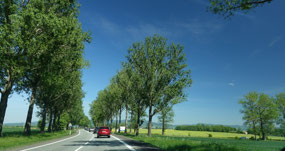
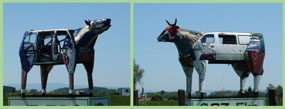
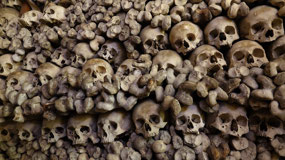
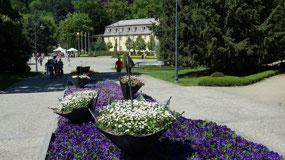
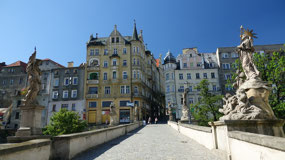
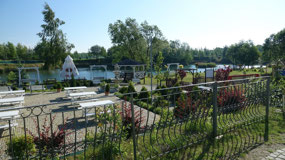




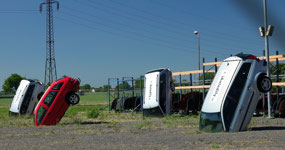
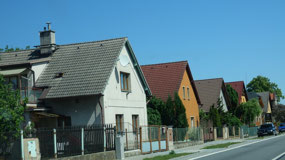
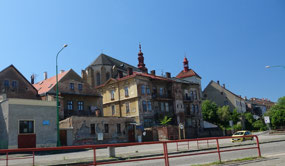
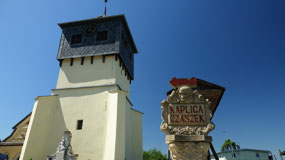

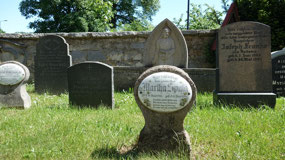
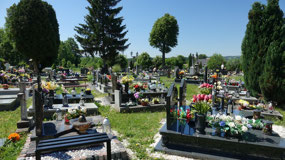
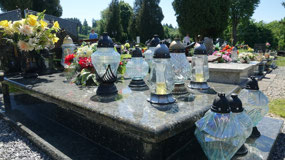
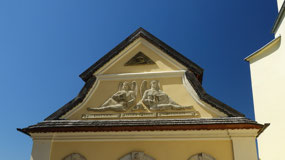
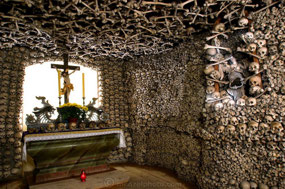
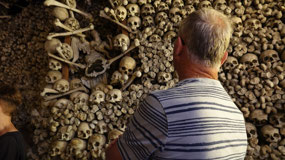
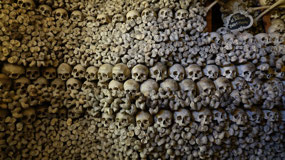
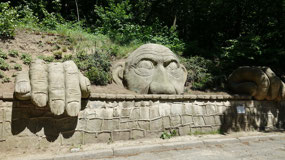
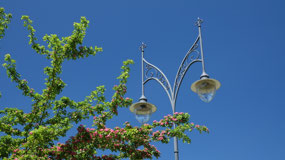
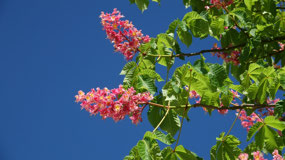
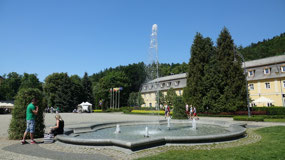
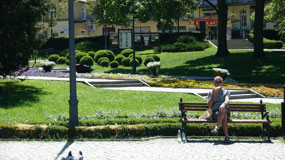
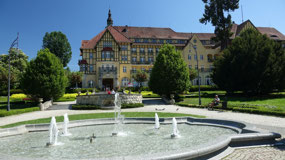
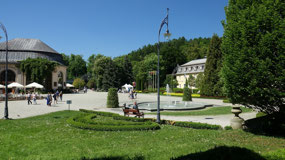
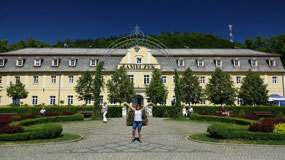
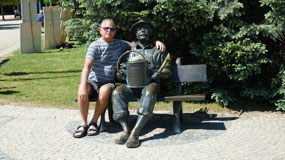
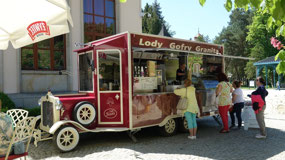
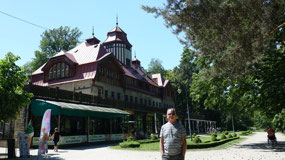
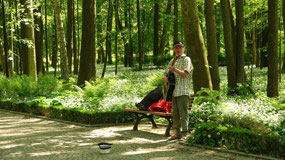
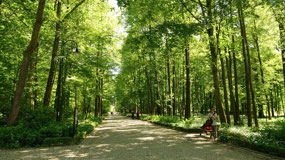
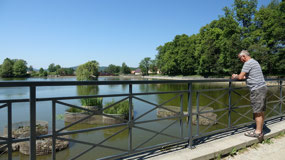
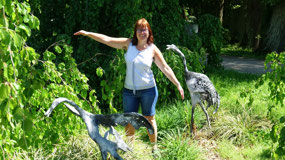
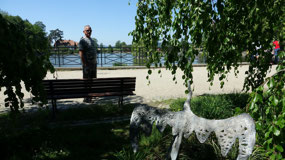
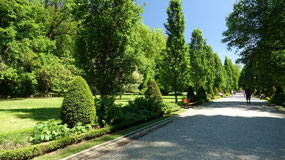
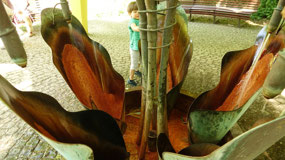
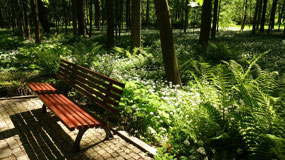
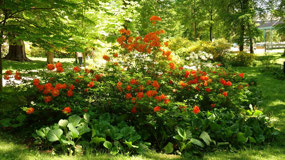
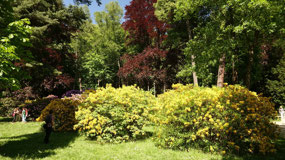
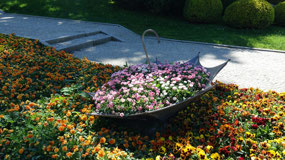
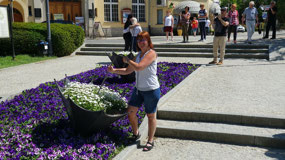
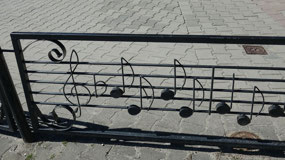

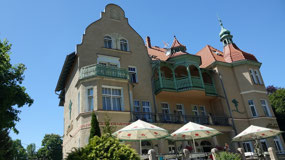
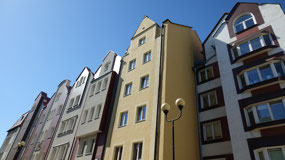
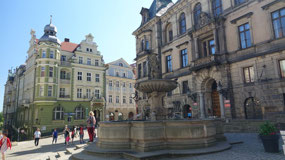
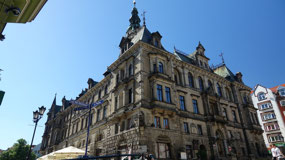
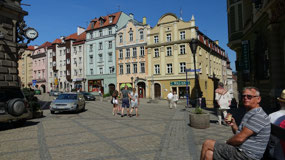
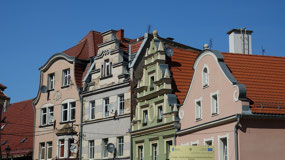
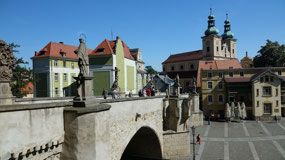
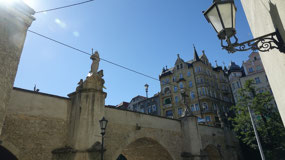
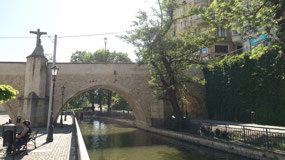
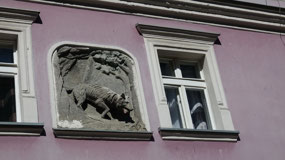
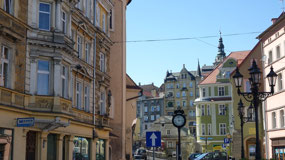
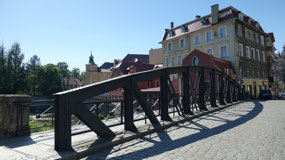
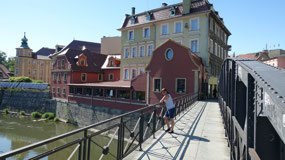
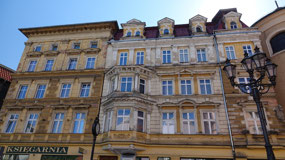
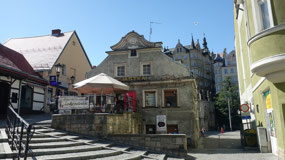
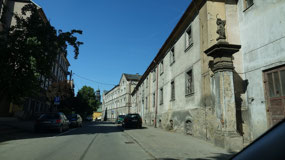
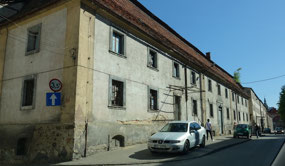
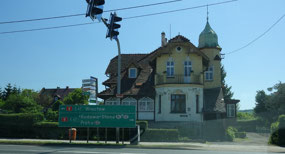
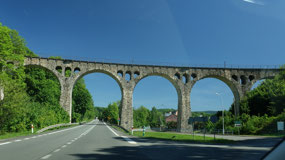
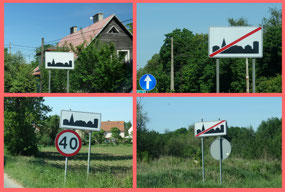

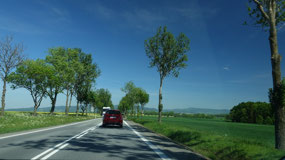
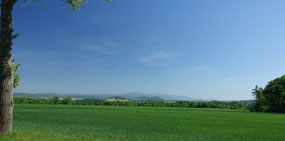
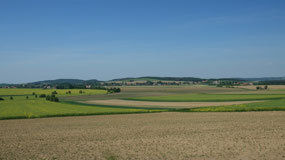
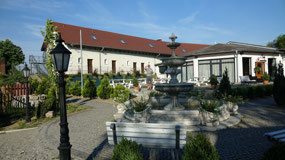
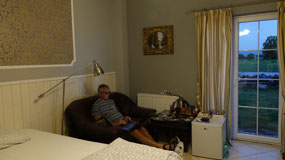
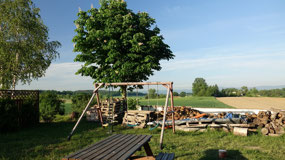
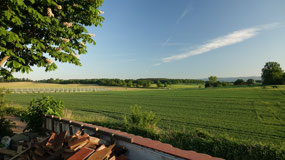
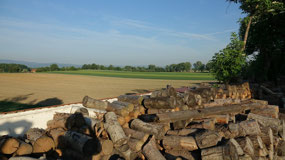
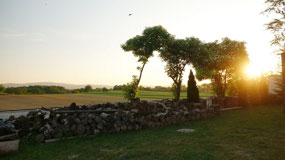
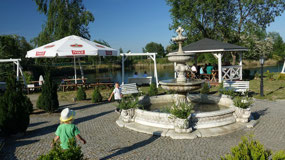
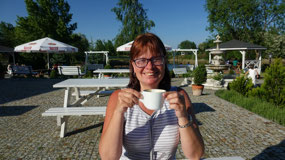
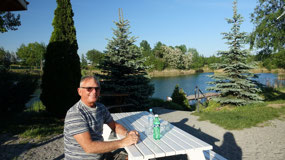
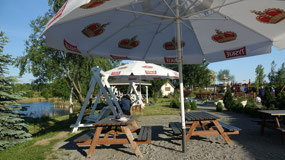
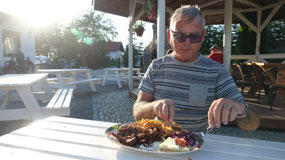
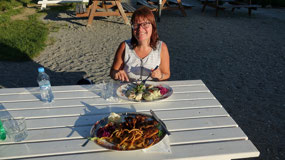

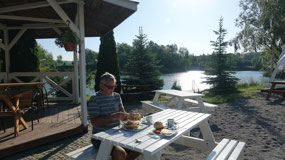

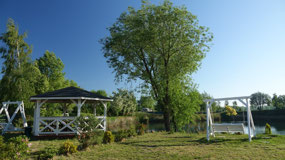
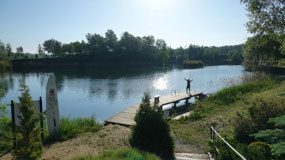
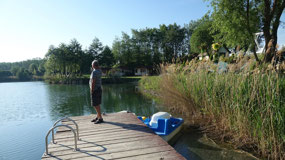
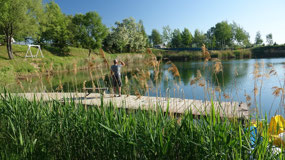
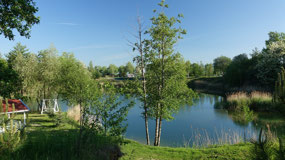
2025-05-23